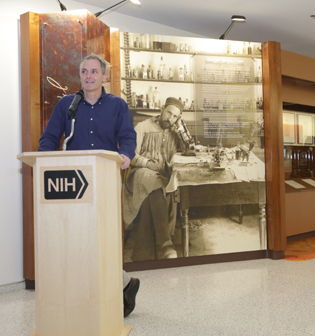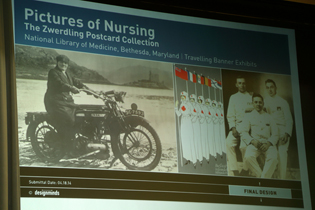News Briefs
NCCAM GETS A NEW NAME
The National Center for Complementary and Alternative Medicine has a new name: the National Center for Complementary and Integrative Health (NCCIH). The revision was mandated as part of the omnibus budget measure signed by President Obama.
The use of an integrative approach to health and wellness has grown within care settings across the United States, including hospitals, hospices, and military health facilities.
“The intent of an integrative approach is to enhance overall health status, prevent disease, and alleviate debilitating symptoms such as pain and chemotherapy-induced nausea, among others. However, the scientific foundation for many complementary approaches is still being built,” said NCCIH Director Josephine P. Briggs. “The mission of NCCIH will remain unchanged. We will continue to focus on the study of the usefulness and safety of complementary and integrative interventions, and provide the public with research-based information to guide health-care decision-making.”
The name change is in keeping with the center’s pre-existing congressional mandate and is aligned with the strategic plan guiding the center’s research priorities and public-education activities. Public comments on a revised name were invited in May and June 2014 and indicated overall support for the change.
NCCIH’s intramural program focuses on pain perception and management integrated in the NIH neuroscience community. Catherine Bushnell, recruited from McGill University, is the scientific director. All this remains in place. Nothing, in fact, changes about NCCAM other than the name, the National Center for Complementary and Integrative Health.
The center’s research priorities include the study of complementary approaches—such as spinal manipulation, meditation, and massage—to manage pain and other symptoms that are not always well addressed by conventional treatments. The center’s research also encourages self-care methods that support healthier lifestyles and uncovers potential usefulness and safety issues of natural products. The practices and products studied by the center are prioritized by four guiding principles: scientific promise, amenability to be studied using the highest quality research methods, use by the American public, and the potential impact on public health.
RENDEZVOUS WITH RAMÓN Y CAJAL AT NIH

BILL BRANSON
NINDS senior investigatory Jeffrey Diamond (shown) helped orchestrate getting the Cajal Institute in Madrid to loan NIH seven of Nobel laureate Santiago Ramón y Cajal’s original drawings of the nervous system. Cajal’s life-size portrait, in the background, is part of the exhibit.
Want to see seven original neural-cell drawings by the father of modern neuroscience, Santiago Ramón y Cajal? Check out the exhibit in NIH’s Porter Neuroscience Research Center. These detailed diagrams of brain cells and his anatomical discoveries formed the basis of the Spanish scientist’s “neuron doctrine” and earned him the Nobel Prize in Physiology or Medicine in 1906, jointly with Camillo Golgi.
The drawings, which are on loan from the Cajal Institute in Madrid, not only honor Cajal’s legacy but are also a source of inspiration to neuroscientists at the NIH. Even former NIH artist-in-residence Rebecca Kamen is fascinated by the brain and its functions and uses Cajal’s illustrations as an inspiration to create bridges between art and science. Kamen, along with NINDS senior investigator Jeffrey Diamond and NINDS science writer Christopher Thomas, spearheaded the effort to bring Cajal’s work to NIH.
In 2013, the three Cajal enthusiasts visited the Cajal Institute to study his works. Thomas facilitated the trip. Diamond gave a scientific talk. Kamen presented the institute with a miniature version of one of her creations—“Butterflies of the Soul.” The sculpture represents Cajal’s illustration of the Purkinje cell; Purkinje cells are found in the brain’s cerebellum.
Diamond and Kamen knew they wanted to bring some of the drawings to NIH and were able to convince the Cajal Institute directors to share their national treasures. The institute’s vice director, Ricardo Martinez Murillo, was even on hand for the drawings’ NIH debut on November 7, 2014.
The idea behind this project was to “encourage collaboration and cross-pollination” among researchers at the recently completed PNRC and “also [to] look back to where it all started with Cajal’s visionary work,” said exhibit content developer Hank Grasso, exhibit developer at the Office of NIH History. He also hopes that this endeavor will lead to radical discoveries in the future, such as those made by Cajal. Grasso envisioned the structure and design of the exhibit and was one of the driving forces behind this collaborative effort.
“The drawings, which represent some of the truly iconic work by Cajal,” were chosen by Diamond based on “the similarity to the work done by the scientists at PNRC.” Currently, there are seven illustrations, which depict the cerebellum; spinal cord; cortical pyramidal cells; retina; hippocampus; dentate gyrus and cornu ammonis 3 (CA3) region of the hippocampus; and continuity versus contiguity (explained below).
The diagram showing the organization of the retina is “a personal favorite and awe-inspiring” to Diamond, as this is the area of the brain his research focuses on. The classical drawing labeled “continuity versus contiguity” explains the difference between Cajal’s theory of contiguous but discrete neurons in the brain, and Golgi’s belief in reticular neural networks.
The exhibit is not only a treat for the eyes, but also provides a tactile experience of the detailed structure of the neurons as depicted in Cajal’s drawings. Jeremy and Nichole Swan (NICHD) developed the three-dimensional prints of the neurons in the exhibit that accompany each drawing. A life-size self-portrait of the young Cajal in his laboratory sits next to his artwork.
In the future, Diamond hopes to continue the collaboration between the two organizations by exchanging the current set of drawings for new sets of other illustrations by Cajal every six months, a sentiment echoed by Murillo as well.
The drawings, which are on the south end of the first floor in Building 35, will remain on display through April 2015.
NEW SURGEON GENERAL
The U.S. Senate confirmed Vivek Murthy as the new surgeon general. He is an attending physician at Brigham and Women’s Hospital (Boston) and an instructor at Harvard Medical School (Boston), where he is an internal medicine hospitalist. He is also co-founder and president of Doctors for America, a grassroots organization of more than 15,000 doctors and medical students in 50 states who are working to build a high-quality, affordable health-care system for all Americans.
In 2011, Murthy was appointed by President Barack Obama to the National Advisory Group on Prevention, Health Promotion, and Integrative and Public Health, where he has worked on developing the National Prevention Strategy. He has lectured widely on health-care reform and physician advocacy, and his writings and research have been published in the Journal of the American Medical Association, Science, the Journal of the National Cancer Institute, and The Washington Post. Murthy’s past research has focused on the participation of women and minorities in cancer clinical trials. Murthy is also the co-founder and chairman of Epernicus, LLC, and its subsidiary TrialNetworks, which build social-networking platforms for life-sciences companies and clinical trials.
PUBLIC IMAGINATION OF NURSING THROUGH POSTCARDS: THEN AND NOW

BILL BRANSON
From angels to calendar girls to modern-day nurses, the image of nursing has changed over the past century. NIH’s National Library of Medicine (NLM) is hosting the exhibit “Pictures of Nursing: The Zwerdling Postcard Collection” to showcase changes in the public perception of nurses as depicted in a century’s worth of postcards. The library acquired a collection of 2,588 postcards from the American nurse and collector Michael Zwerdling. From these, around 50 historic postcards from 1893 to 2011 are displayed including many from the early 1900s, which was considered the “Golden Age” of postcards.
You can visit the exhibit in person at NLM’s History of Medicine Division through August 21, 2015, or explore the digital exhibit, which features more than 500 postcards, at http://www.nlm.nih.gov/exhibition/picturesofnursing/index.html.
This page was last updated on Tuesday, April 26, 2022
